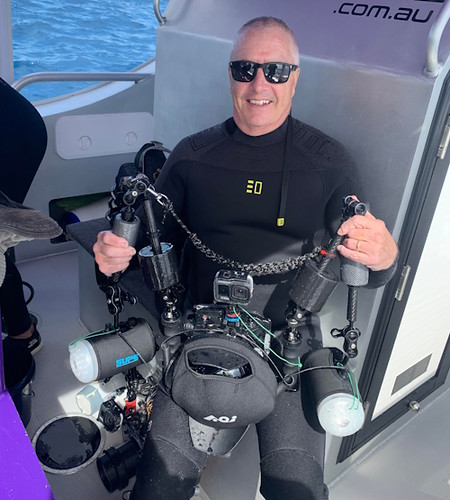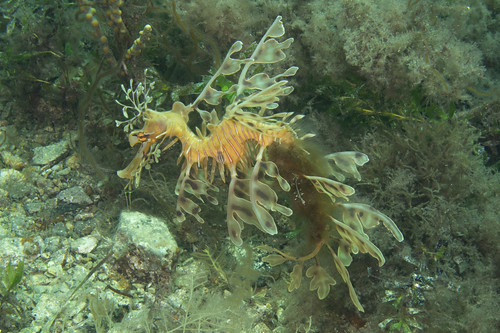A few weeks ago, I was sitting on the sand, at a local beach, taking a break between dives where I was taking fish pictures for the project. Several of the nearby rockpool swimmers, also locals, recognised my gear and came over to say hello, and generally enquire about sharks.
This time, as one of the swimmers walked over, we both noticed a large sailboat leaving the river for the open ocean. My friend remarked that it was his dream to one day, buy a sailboat and travel around the world.” Looking at me, he must have picked up that I did not share his dream. “Yes,” I remarked, “I like 'the idea' of sailing the world, as a concept, it sounded quite pleasing.” I was probably not very convincing. I do, however, have what I believe to be, a typical realistic 'sailing off into the sunset' story. In my case two of my friends who met and dated for a while, decided sailing was their future. They both sold off all their worldly belongings, bought a sailboat, tried to learn how to sail, failed to learn the basics, had a falling out and eventually, went their separate ways, selling the boat. Perhaps that put me off the idea of cruising the world, without worries.
That said, there must be something magical as well as educational about traveling around on a private boat, exploring the remaining 70% of the earth’s surface. For someone interested in the natural environment, it must be a life-changing experience, bringing the naturalist into close contact with the environment.
An example of someone who actually sailed off into the sunset is this bio blurb’s subject, Owen. He is one of the leading fish identifiers in the project. Known to project participants as
@meta4, he is ranked 7th on
identifications list, contributing 15,621 identifications to Australasian Fishes. He has posted over 66,551 identifications across the iNaturalist. Personally, I am extremely grateful to Owen, especially with his identifications of marine tropical fish, of which he seems to have an encyclopedic knowledge.
Before his experience cruising, Owen grew up in Queensland. (He notes that for the last five years, he’s been 'exiled' to an inland town in Victoria.) Growing up, Owen was always interested in nature, but was obsessed with marine and freshwater life. He tells us that, “By age 9 or 10, I was making dip nets, exploring local creeks and keeping freshwater fish. I bought my first fish book (Jacaranda pocket guide to fishes of Australia by G.P. Whitley) and started learning Latin names.”
A couple of years later, Owen was snorkeling, observing and catching fish in the wild. He kept up with his aquarium hobby and by the time he was in high school, he spent afternoons and weekends working in one of the first aquarium shops in his area which featured marine fish.
This appears to be the real beginning of a career path to becoming a passionate naturalist. He tells us part of the job of working in the shop was, “Unpacking the new shipments to see which brightly coloured species had arrived. This was always exciting.”
Upon leaving school and getting a job, he suddenly had an income that went on scuba equipment and underwater cameras. Furthermore, he kept a saltwater aquarium and continued to find much pleasure in observing marine fish in their natural environment. As mentioned above, he lived aboard a yacht for four years and dove all along Queensland's east coast and spent a year in Papua New Guinea. As you might expect, the cruising experience made a big impression, as previously he had a career in big computers (when that was a thing), but after his time at sea, he found it difficult to settle down. Career changes followed.
He was next employed as a nature guide at Cape York and Qld National Parks for 20 years. Later he went to uni and got a science degree. With the degree he tells us, “I worked in environmental consulting as an ecologist and got to travel all over Queensland as well as large parts of the Northern Territory and NSW.”
Being a naturalist as both a profession and a hobby has remained with Owen. He tells me that he spends some time on iNat most days. “I started because I had an interest in the orchids of Victoria and wanted to learn what's here and where they are. I also did it to stay in touch with the plants and animals I was familiar with from back in Queensland and learn more about the flora and fauna of where I'm living now. Fish were always my first love and I usually start with fish on iNat, before moving on to see what orchids and general flora and fauna are showing up.”
He finds that iNaturalist is an exceptional educational tool, expanding his understanding of the natural world, even in places he has never visited. He tells us, “I haven't dived in southern Australia and before I found iNat, I mostly knew the temperate fish fauna from books. But iNat has been a great way to increase my knowledge of that area. I have a lot of fish ids on iNat, but they only account for about a quarter of my total. Biogeography has always fascinated me and I've always been interested in what occurs where, what doesn't and why. iNat gives a great overall view of the ranges for a wide spectrum of species. iNat is also good for finding others with interests that overlap and exchanging information. I've made some good friends through iNat and had some memorable field trips with them.”
With his vast professional experience with nature and the iNaturalist software, I asked Owen to give us some words of advice for our newer project and iNat participants. He suggests, “iNat isn't just for posting your observations, it's a great information source. You can use it to find out what occurs where you are or anywhere you are interested in and see photos that show the variation within a species, much better than books can.”
For those posting observations, Owen suggests, “When you are uploading to iNat, the better your photos, the easier it is for someone to id. The subject should be in focus and where possible, prominent in the image. It helps if the image shows the features that help to id the species and distinguish it from similar species. If you don't know which features will help to id something, the better the photo or photos, the better your chances of getting an id.”
Using trees as an example, Owen tells us, “Eucalypts are a good example for this. To identify most eucalypt trees, a botanist needs to see details of the bark, the leaves, the buds and gumnuts as well as the tree shape. Often, I can come close to an id for a eucalypt tree from just the bark or a general photo, but can't tell which of three very similar species without seeing the buds or gumnuts.
It's frustrating to see so many eucalypt uploads that just have one photo and are probably never going to be identified.”
It’s remarkable to think that the dream of cruising the seven seas can either set you on a fulfilling, lifelong path of loving and learning about the natural environment or result in a messy divorce and a cheap sailboat for sale. Take your pick. Personally, I am very grateful to Owen, who has contributed so much to the Australasian Fishes project and fish identification, and I am slightly grateful to my divorced friends who, not only provided me with a good apocryphal story, but may have prevented me from having to quickly sell a large boat after a falling out. The dream of cruising is still intact.
This journal post was written by Australasian Fishes member,
Harry Rosenthal.
























